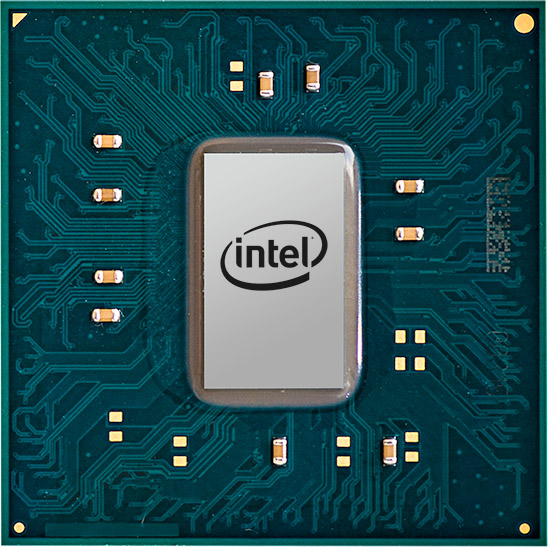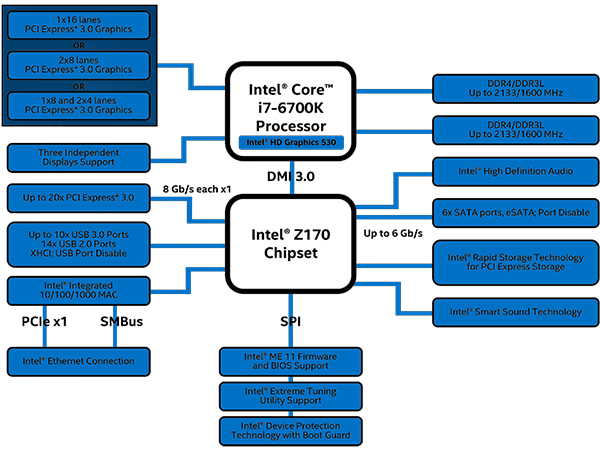Skylake: Intel's Core i7-6700K And i5-6600K
Intel gave us an early look at the Core i7-6700K, i5-6600K and Z170 chipset two weeks ahead of IDF and the unveiling of Skylake's architectural details.
Intel Z170 Chipset
What, exactly, is capable of utilizing that plus-sized pipe? Arguably more exciting than the new Core CPUs themselves are Intel’s 100-series chipsets. The company hasn’t formally announced every model yet. Rather, it’s only talking about the flagship Z170—and that’s fine with us, since, from an enthusiast standpoint, everything else is a subset of the Z170’s feature set.
Certain familiar features naturally carry over from the 9-series PCH family. There’s an integrated gigabit Ethernet MAC with a single-lane connection for attaching a PHY. And you still get six SATA 6Gb/s ports for storage, along with HD Audio support.
There’s a lot more that changes, though. USB connectivity evolves to enable as many as 10 USB 3.0 ports and 14 USB 2.0 ports. Z97, for example, offered six USB 3.0 and 14 USB 2.0 ports. That’s nice—but nowhere near as notable as the 20 lanes of PCI Express 3.0 originating from the PCH. Together with software optimizations in Intel’s Rapid Storage Technology driver, we end up with the first desktop platform designed with PCIe-based storage in mind.
Now, you don't get 20 lanes of PCIe, six SATA ports, M.2 connectors, all of the USB, and GbE at the same time. Z170 is highly configurable, so motherboard manufacturers have to pick and choose how they utilize its "ports". Six of 26 are used up by USB 3.0 (which is where "up to 20 PCIe lanes" comes from). With the remainder, your vendor of choice can tap into another four USB 3.0 ports, SATA, and PCIe-based storage. But they all eat into Z170's connectivity. Populating all six SATA 6Gb/s ports, for example, eats into six lanes. A PCIe storage device monopolizes four. On the Z170A Gaming M7 motherboard we’re using to test, MSI exploits the flexible PCH with four PCIe x1 slots and one PCIe x4 slot, an ASMedia ASM1142 USB 3.1 controller that consumes two lanes and two M.2 slots that appear to share a four-lane link. MSI juggles the various upgrade paths with PCIe switches.
Intel's RST driver continues to support RAID 0, 1, 5 and 10 across SATA devices, but then adds RAID 0 and 1 functionality for PCIe-based SSDs in the M.2 slots, according to MSI’s manual. You can use one of those PCH-derived slots for a graphics card, and the bandwidth increase over DMI 3.0 would undoubtedly improve your experience over previous-gen platforms. MSI says its board will do three-way CrossFire this way. Conversely, Nvidia continues to limit CPUs with 16 lanes of third-gen PCIe to two-way SLI.
Beyond those capabilities easily covered by a block diagram, Z170 is the only chipset with official support for overclocking (that’s full support on K-series parts and partial overclocking on certain non-K parts). Intel seems to be taking tuning much more seriously with Skylake, too. Many of the limitations that worked their way into previous-generation architectures are now gone, giving you the freedom to explore your processor’s potential, even if there’s no guarantee you’ll be breaking clock rate records with the new capabilities.
Get Tom's Hardware's best news and in-depth reviews, straight to your inbox.

Igor Wallossek wrote a wide variety of hardware articles for Tom's Hardware, with a strong focus on technical analysis and in-depth reviews. His contributions have spanned a broad spectrum of PC components, including GPUs, CPUs, workstations, and PC builds. His insightful articles provide readers with detailed knowledge to make informed decisions in the ever-evolving tech landscape

